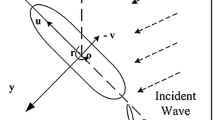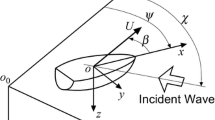Abstract
The behavior of a ship in regular waves during maneuvering was studied by using a two-time scale model. The maneuvering analysis was based on Söding’s (Schiffstechnik 1982; 29:3–29) nonlinear slender-body theory generalized to account for heel. Forces and moments due to rudder, propeller, and viscous cross-flow follow from the state-of-the-art procedures. The developed unified theory of seakeeping and maneuvering was verified and validated for calm water by comparing it with experimental and calculated zigzag and circle maneuvers. Linear wave-induced motions and loads were determined by generalizing the Salvesen-Tuck-Faltinsen (Trans SNAME 1970; 78:250–287) strip theory. The mean second-order wave loads in incident regular deep water waves in oblique sea conditions were estimated by the potential flow theories of Faltinsen et al. (Proc 13th Symp Naval Hydrody 1980), Salvesen (Proc Intl Symp Dynam Mar Vehicl Struct Wave 1974), and Loukakis and Sclavounos (J Ship Res 1978; 22:1–19). The considered theories cover the whole range of important wavelengths. Comparisons between the different mean second-order wave load theories and available experimental data were carried out for different ship hull forms when the ship was advancing forward on a straight course. The mentioned methods have been incorporated into the maneuvering model. Their applicability from the perspective of the maneuvering ability of the selected types of ships was investigated in given wave environments. The wave conditions are valid for realistic maneuvering cases in open coastal areas. It was demonstrated that the incident waves may have an important influence on the maneuvering behavior of a ship. The added resistance, mean second-order transverse force, and yaw moment also play important roles.














Similar content being viewed by others
References
Cummins WE (1962) The impulse response function and ship motions. Schiffstechnik 9:101–109
Bailey PA, Price WG, Temarel P (1997) A unified mathematical model describing the maneuvering of a ship travelling in a seaway. Trans RINA 140:131–149
Fossen TI (2005) A nonlinear unified state-space model for ship maneuvering and control in a seaway. Int J Bifurcat Chaos 15:2717–2746
Faltinsen OM, Minsaas K, Liapis N, Skjørdal SO (1980) Prediction of resistance and propulsion of a ship in a seaway. In: Proceedings of the 13th symposium on naval hydrodynamics, Tokyo, pp 505–529
Faltinsen OM (1990) Sea loads on ships and offshore structures. Cambridge University Press, Cambridge
Neal E (1974) Second-order hydrodynamic forces due to stochastic excitation. In: Proceedings of the 10th symposium on naval hydrodynamics, Cambridge, MA, USA, pp 517–539
Hasselmann K (1966) On nonlinear ship motions in irregular waves. J Ship Res 10:64–68
McCreight WR (1986) Ship maneuvering in waves. In: Proceedings of the 16th symposium on naval hydrodynamics, Berkeley, pp 456–469
Ottosson P, Bystorm L (1991) Simulation of the dynamics of a ship maneuvering in waves. Trans SNAME 99:281–298
Fang MC, Luo JH, Lee ML (2005) A nonlinear mathematical model for ship turning circle simulation in waves. J Ship Res 49(2):69–79
Hirano M, Takashina J, Takeshi K, Saruta T (1980) Ship turning trajectory in regular waves. Trans West-Japan Soc of Naval Arch 90:17–31
Artyszuk J (2003) Wave effects in ship maneuvering motion MM—a review analysis. In: Proceedings of the international conference on marine simulation and ship manoeuvrability, vol 3, Kanazawa, Japan. http://nippon.zaidan.info/seikabutsu/2003/00574/contents/0348.htm. Accessed 10 July 2008
Ueno M, Nimura T, Miyazaki H, Nonaka K (2001) On steady horizontal forces and moment due to short waves acting on ships in manoeuvring motion. In: Proceedings of the 8th international symposium on practical design of ships and other floating structures, Shanghai, pp 671–677
Ueno M, Nimura T, Miyazaki H (2003) Experimental Study on Manoeuvring Motion of a Ship in Waves. In: Proceedings of MARSIM 2003, vol 3, Kanazawa. http://nippon.zaidan.info/seikabutsu/2003/00574/contents/0352.htm. Accessed 14 July 2008
Maruo H (1960) The drift of a body floating in waves. J Ship Res 4:1–10
Maruo H (1963) Resistance in Waves. 60th Anniversary Series, vol 8, The Society of Naval Architects of Japan, pp 67–102
Newman JN (1967) The drift force and moment on ships in waves. J Ship Res 11:51–60
Kashiwagi M (1992) Added resistance, wave-induced steady sway force and yaw moment on an advancing ship. Ship Technol Res 39:3–16
Salvesen N (1974) Second-order steady state forces and moments on surface ships in oblique regular waves. In: Proceedings of the international symposium on dynamics of marine vehicles and structures in waves, University College, London, pp 212–227
Loukakis TA, Sclavounos PD (1978) Some extensions of the classical approach to strip theory of ship motions, including the calculation of mean added forces and moments. J Ship Res 22:1–19
Gerritsma J, Beukelman V (1971) Analysis of the resistance increase in waves of a fast cargo ship. Report No. 334, Laboratory for Ship Hydrodynamics, Delft
Steen S, Faltinsen OM (1998) Added Resistance of a Ship in Small Sea States. In: Proceedings of the 7th international symposium on practical design of ships and mobile units, The Hague, pp 521–526
Fujii H and Takahashi T (1975) Experimental study on the resistance increase of a ship in regular oblique waves. In: Proceedings of the 14th ITTC, vol 4, Ottawa, pp 351–360
Sakamoto T, Baba E (1986) Minimization of resistance of slowly moving full hull forms in short waves. In: Proceedings of the 16th symposium on naval hydrodynamics, Berkeley, pp 598–612
Matsumoto K, Naito S, Takagi K, Hirota K, Takagishi K (1998) Beak-bow to reduce the wave added resistance at sea. In: Proceedings of the 7th international symposium on practical design of ships and mobile units, The Hague, pp 527–533
Salvesen N, Tuck EO, Faltinsen OM (1970) Ship motions and sea loads. Trans SNAME 78:250–287
Grue J, Palm E (1993) The mean drift force and yaw moment on marine structures in waves and current. J Fluid Mech 250:121–142
Skejic R, Faltinsen OM (2006) A unified seakeeping and maneuvering analysis of a monohull in regular incident waves. In: Proceedings of the 7th international conference on hydrodynamics, Ischia, pp 97–104
Pérez A, Clemente JA (2001) Remarks about the mathematical problems in manoeuvrability. In: 36th WEGEMT Summer School, Manoeuvring and manoeuvring devices, Rome, Italy. http://canal.etsin.upm.es/publicaciones/articulos/paper_wegemt_1.pdf. Accessed 10 July 2008
ITTC (1975) The Mariner model cooperative test program—correlations and applications. Report of the Manoeuvrability Committee. Appendix V. In: Proceedings of the 14th ITTC, vol 2, Ottawa, pp 414–427
Söding H (1982) Prediction of ship steering capabilities. Schiffstechnik 29:3–29
Imlay FH (1961) The complete expressions for added mass of a rigid body moving in an ideal fluid. DTMB Report 1528, Washington, DC
Salvesen N, Smith WE (1970) Comparison of ship motion theory and experiment for mariner hull and destroyer with modified bow. NSRDC Report 3337, Washington, DC
Chislett MS, Strøm–Tejsen J (1965) Planar motion mechanism tests and full-scale steering maneuvering predictions for a mariner class vessel. Report no. HyA 6. Hydro-og Aerodynamisk Laboratorium, Lyngby
ITTC (1983) 15th and 16th ITTC Seakeeping Committee. Summary of results obtained with computer programs to predict ship motions in six degree of freedom and related responses (1976–1981). ITTC
Newman JN (1977) Marine hydrodynamics. MIT Press, Cambridge
Brix J (1993) Maneuvering technical manual. Seehafen-Verlag, Hamburg
Faltinsen OM (2005) Hydrodynamics of high-speed marine vehicles. Cambridge University Press, Cambridge
Norrbin NH (1970) Theory and observation on the use of a mathematical model for ship maneuvering in deep and confined waters. In: Proceedings of the 8th symposium on naval hydrodynamics, Pasadena, pp 807–904
Artyszuk J (2003) A look into motion equations of the Esso Osaka maneuvering. Int Shipbuild Prog 50(4):297–315
IMO (2002) Standards for ship manoeuvrability. MSC Circular 137(76), International Maritime Organisation, London
Ankudinov V, Kaplan P, Jacobsen BK (1993) Assessment and principal structure of the modular mathematical model for ship maneuverability prediction and real-time maneuvering simulations. In: Proceedings of the international conference on marine simulation and ship manoeuvrability, St. Johns
Naito S, Takagishi K (1998) Steady behavior of a full large ship at sea. In: Proceedings of the 7th international symposium on practical design of ships and mobile units, The Hague, pp 223–229
Burnay S, Ankudinov V (2003) The prediction of Hydrodynamic forces acting on the hull of a maneuvering ship based upon a database of prediction methods. In: Proceedings of MARSIM 2003, vol 3, Kanazawa. http://nippon.zaidan.info/seikabutsu/2003/00574/contents/0277.htm. Accessed 14 July 2008
ITTC (2002) The Specialist Committee on Esso Osaka. Final Report and Recommendations to the 23rd ITTC. In: Proceedings of the 23rd ITTC, vol 2, Italian Ship Model Basin (INSEAN), Venice, pp 581–617. http://ittc.sname.org/proc23/Esso%20Osaka.pdf. Accessed 10 July 2008
DNV (2005) Hull equipment and safety. Det Norske Veritas, Part 3, Chap. 3, Sect. 2, Høvik
Söding H (1998) Limits of potential theory in rudder flow predictions. Ship Technol Res 45:141–155
Holtrop J, Mennen GGJ (1982) An approximate power prediction method. Int Shipbuild Progr 29:166–170
Gutsche F (1955) Die Induktion der axialen Strahlzusatzgeschwindigkeit in der Umgebung der Propellerebene. Schiffstechnik 3:31–33
Michell JH (1898) The wave resistance of a ship. Phil Mag 45:106–123
Kara F, Vassalos D (2005) Time domain computation of the wave-making resistance of ships. J Ship Res 49:144–158
Oosterveld MWC, Oossanen van P (1975) Further Computer-Analyzed Data of Wageningen B-Screw Series. Report No. 479, I.S.P. 22(251), N.M.S.B
Breslin JP, Andersen P (1994) Hydrodynamics of ship propellers. Cambridge University Press, Cambridge
Russo VL, Sullivan EK (1953) Design of the mariner-type ship. Trans. SNAME 61:98–218
Kijima K, Tanaka S, Furukawa Y, Hori T (1993) On a prediction method of ship maneuvering characteristics. In: Proceedings of MARSIM 1993, St. Johns, vol 1, pp 285–294
Zhao R, Faltinsen OM (1990) Interaction between current, waves and marine structures. In: Proceedings of the 5th international conference on numerical ship hydrodynamics, Hiroshima, pp 513–527
Spens PG, Lalangas PA (1962) Measurements of the mean lateral force and yawing moment on a Series 60 model in oblique regular waves. Report no. SIT-DL-880, Davidson Laboratory, Stevens Institute of Technology, Hoboken
Journée JMJ (1976) Motions and resistance of a ship in regular following waves. Report No. 0440, Ship Hydromechanics Laboratory, Delft University of Technology
Simonsen CD (2000) Rudder, propeller and hull interaction by RANS. PhD thesis, Department of Naval Architecture and Offshore Engineering, DTU, Lyngby
Sibul OJ (1971) Measurements and calculations of ship resistance in waves. Technical report No. NA-71-3, College of Engineering, University of Berkeley
Strøm-Tejsen J, Yeh HYH, Moran DD (1973) Added resistance in waves. Trans SNAME 81:109–143
Acknowledgments
The authors acknowledge financial support from the Research Council of Norway and the Centre for Ships and Ocean Structures (CeSOS), Norwegian University of Science and Technology.
Author information
Authors and Affiliations
Corresponding author
About this article
Cite this article
Skejic, R., Faltinsen, O.M. A unified seakeeping and maneuvering analysis of ships in regular waves. J Mar Sci Technol 13, 371–394 (2008). https://doi.org/10.1007/s00773-008-0025-2
Received:
Accepted:
Published:
Issue Date:
DOI: https://doi.org/10.1007/s00773-008-0025-2




